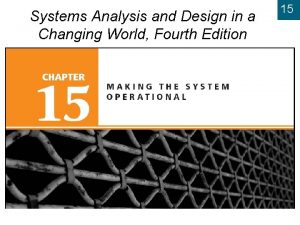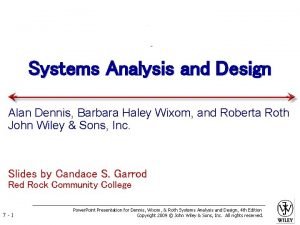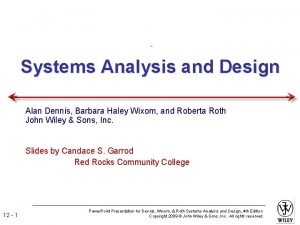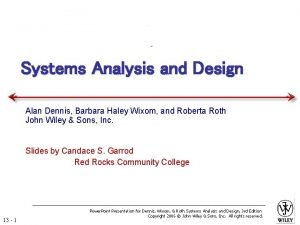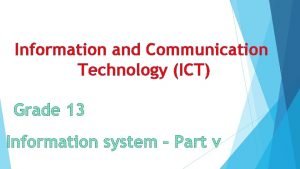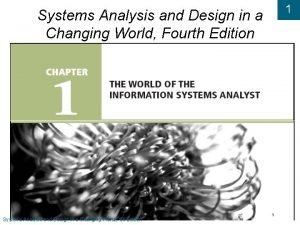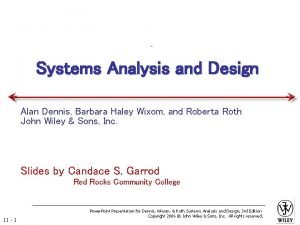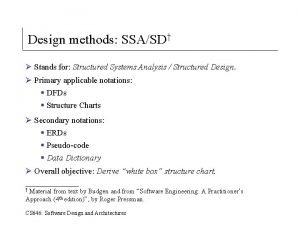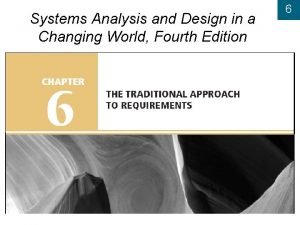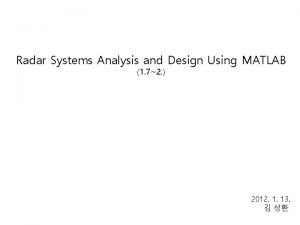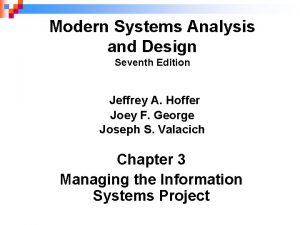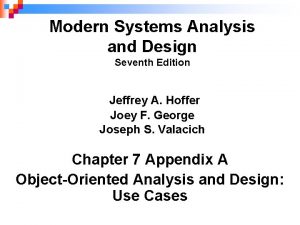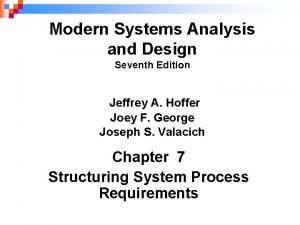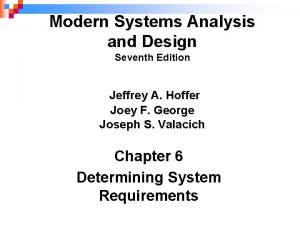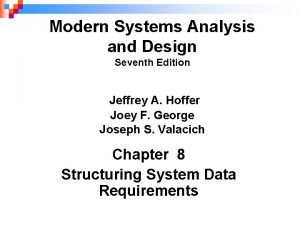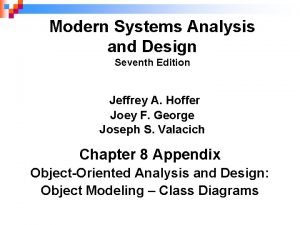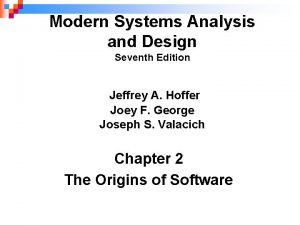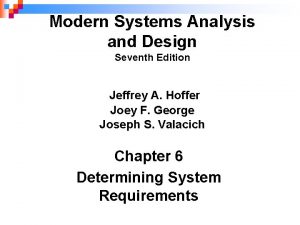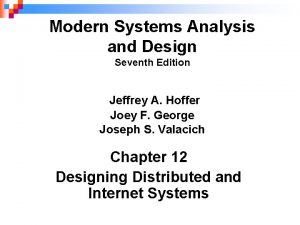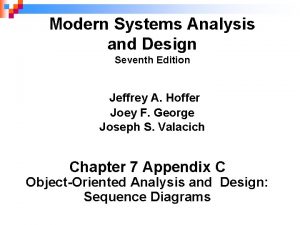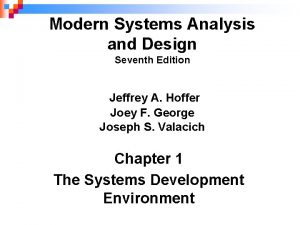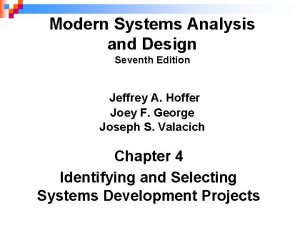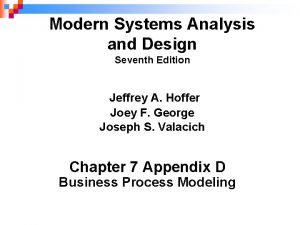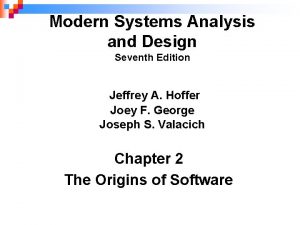Modern Systems Analysis and Design Seventh Edition Jeffrey














































- Slides: 46

Modern Systems Analysis and Design Seventh Edition Jeffrey A. Hoffer Joey F. George Joseph S. Valacich Chapter 4 Identifying and Selecting Systems Development Projects

Learning Objectives ü ü Describe the project identification and selection process. Describe corporate strategic planning and information systems planning process. Explain the relationship between corporate strategic planning and information systems planning. Describe how information systems planning can be used to assist in identifying and selecting systems development projects. Chapter 4 Copyright © 2014 Pearson Education, Inc. Publishing as Prentice Hall 2

Learning Objectives (Cont. ) ü Analyze information systems planning matrices to determine affinity between information systems and IS projects and to forecast the impact of IS projects on business objectives. ü Describe three classes of Internet electronic commerce applications: business-to-consumer, business-to-employee, and business-to-business. Chapter 4 Copyright © 2014 Pearson Education, Inc. Publishing as Prentice Hall 3

Identifying and Selecting Systems Development Projects FIGURE 4 -1 Systems development life cycle with project identification and selection highlighted Three main steps: 1. Identifying potential development projects 2. Classifying and ranking IS development projects 3. Selecting IS development projects Chapter 4 Copyright © 2014 Pearson Education, Inc. Publishing as Prentice Hall 4

The Process of Identifying and Selecting IS Development Projects 1. Identifying potential development projects ¨ Identification from a stakeholder group n Chapter 4 Each stakeholder group brings their own perspective and motivation to the IS decision. Copyright © 2014 Pearson Education, Inc. Publishing as Prentice Hall 5

The Process of Identifying and Selecting IS Development Projects (Cont. ) ¨ Top-down source are projects identified by top management or by a diverse steering committee. ¨ Bottom-up source are project initiatives stemming from managers, business units, or the development group. ¨ The process varies substantially across organizations. Chapter 4 Copyright © 2014 Pearson Education, Inc. Publishing as Prentice Hall 6

The Process of Identifying and Selecting IS Development Projects (Cont. ) Chapter 4 Copyright © 2014 Pearson Education, Inc. Publishing as Prentice Hall 7

The Process of Identifying and Selecting IS Development Projects (Cont. ) 2. Classifying and ranking IS development projects ¨ Using value chain analysis or other evaluation criteria n Value chain analysis: Analyzing an organization’s activities to determine where value is added to products and/or services and the costs incurred for doing so; usually also includes a comparison with the activities, added value, and costs of other organizations for the purpose of making improvements in the organization’s operations and performance Chapter 4 Copyright © 2014 Pearson Education, Inc. Publishing as Prentice Hall 8

The Process of Identifying and Selecting IS Development Projects (Cont. ) FIGURE 4 -2 Organizations can be thought of as a value chain, transforming raw materials into products for customers. Chapter 4 Copyright © 2014 Pearson Education, Inc. Publishing as Prentice Hall 9

The Process of Identifying and Selecting IS Development Projects (Cont. ) Chapter 4 Copyright © 2014 Pearson Education, Inc. Publishing as Prentice Hall 10

The Process of Identifying and Selecting IS Development Projects (Cont. ) 3. Selecting IS development projects Based on various factors ¨ Both short- and long-term projects considered ¨ Most likely to achieve business objectives selected ¨ A very important and ongoing activity ¨ Chapter 4 Copyright © 2014 Pearson Education, Inc. Publishing as Prentice Hall 11

The Process of Identifying and Selecting IS Development Projects (Cont. ) FIGURE 4 -3 Project selection decisions must consider numerous factors and can have numerous outcomes. Chapter 4 Copyright © 2014 Pearson Education, Inc. Publishing as Prentice Hall 12

The Process of Identifying and Selecting IS Development Projects (Cont. ) n One method for deciding among different projects or alternative designs: For each requirement or constraint: Score = weight X rating ¨ Each alternative: sum scores across requirements/constraints ¨ Alternative with highest score wins ¨ Chapter 4 Copyright © 2014 Pearson Education, Inc. Publishing as Prentice Hall 13

The Process of Identifying and Selecting IS Development Projects (Cont. ) FIGURE 4 -4 Alternative projects and system design decisions can be assisted using weighted multicriteria analysis. Chapter 4 Copyright © 2014 Pearson Education, Inc. Publishing as Prentice Hall 14

Deliverables and Outcomes n n Primary deliverable from the first part of the planning phase is a schedule of specific IS development projects. Outcome of the next part of the planning phase —project initiation and planning—is the assurance that careful consideration was given to project selection and each project can help the organization reach its goals. Chapter 4 Copyright © 2014 Pearson Education, Inc. Publishing as Prentice Hall 15

Deliverables and Outcomes (Cont. ) n Incremental commitment: a strategy in systems analysis and design in which the project is reviewed after each phase and continuation of the project is rejustified Chapter 4 Copyright © 2014 Pearson Education, Inc. Publishing as Prentice Hall 16

Deliverables and Outcomes (Cont. ) Figure 4 -5 Information systems development projects come from both top-down and bottom-up initiatives. Chapter 4 Copyright © 2014 Pearson Education, Inc. Publishing as Prentice Hall 17

Corporate and Information Systems Planning n To benefit from a planning-based approach for identifying and selecting projects, an organization must: Analyze its information needs thoroughly. ¨ Plan its projects carefully. ¨ Chapter 4 Copyright © 2014 Pearson Education, Inc. Publishing as Prentice Hall 18

Reasons for Importance of Improved Planning n n n Increasing cost of information systems (40% of organizational expense) Lack of cross-organizational applications and systems Systems don’t address critical strategic problems Too much data redundancy, lack of data quality High system maintenance costs Long application backlogs Chapter 4 Copyright © 2014 Pearson Education, Inc. Publishing as Prentice Hall 19

Corporate Strategic Planning Ongoing process that defines mission, objectives, and strategies of an organization n Corporate strategy involves: n ¨ Mission statement ¨ Objective statements ¨ Description of competitive strategy Chapter 4 Figure 4 -6 Corporate strategic planning is a three step Process. Copyright © 2014 Pearson Education, Inc. Publishing as Prentice Hall 20

Corporate Strategic Planning (Cont. ) n Mission statement: a statement that makes it clear what business a company is in Figure 4 -7 Mission statement (Pine Valley Furniture) Chapter 4 Copyright © 2014 Pearson Education, Inc. Publishing as Prentice Hall 21

Corporate Strategic Planning (Cont. ) n Objective statement: a series of statements that express an organization’s qualitative and quantitative goals for reaching a desired future position Chapter 4 Copyright © 2014 Pearson Education, Inc. Publishing as Prentice Hall 22

Corporate Strategic Planning (Cont. ) FIGURE 4 -8 Statement of Corporate Objectives (Pine Valley Furniture) Chapter 4 Copyright © 2014 Pearson Education, Inc. Publishing as Prentice Hall 23

Corporate Strategic Planning (Cont. ) Competitive strategy: the method by which an organization attempts to achieve its mission and objectives n Main types: n ¨ Low-cost producer ¨ Product differentiation ¨ Product focus or niche Chapter 4 Copyright © 2014 Pearson Education, Inc. Publishing as Prentice Hall 24

Corporate Strategic Planning (Cont. ) Chapter 4 Copyright © 2014 Pearson Education, Inc. Publishing as Prentice Hall 25

Information Systems Planning (ISP) An orderly means of assessing the information needs of an organization and defining the systems, databases, and technologies that will best meet those needs n ISP must be done in accordance with the organization’s mission, objectives, and competitive strategy. n Chapter 4 Copyright © 2014 Pearson Education, Inc. Publishing as Prentice Hall 26

Information Systems Planning (Cont. ) FIGURE 4 -10 Parallel activities of corporate strategic planning and information systems planning Chapter 4 Copyright © 2014 Pearson Education, Inc. Publishing as Prentice Hall 27

Information Systems Planning (Cont. ) n Top-down planning attempts to gain a broad understanding of information system needs of the entire organization and offers: ¨ Broader perspective. ¨ Improved integration. ¨ Improved management support. ¨ Better understanding. Chapter 4 Copyright © 2014 Pearson Education, Inc. Publishing as Prentice Hall 28

Information Systems Planning (Cont. ) n Bottom-up planning identifies IS development projects based on solving specific operational business problems or taking advantage of specific opportunities. ¨ Can be faster and less costly, so may be beneficial in certain circumstances. Chapter 4 Copyright © 2014 Pearson Education, Inc. Publishing as Prentice Hall 29

Information Systems Planning (Cont. ) FIGURE 4 -11 Information systems planning information (Pine Valley Furniture) Chapter 4 Copyright © 2014 Pearson Education, Inc. Publishing as Prentice Hall 30

Information Systems Planning (Cont. ) n Functional Decomposition: breaking high-level abstract information into smaller units for more detailed planning Chapter 4 Copyright © 2014 Pearson Education, Inc. Publishing as Prentice Hall 31

Information Systems Planning (Cont. ) FIGURE 4 -12 Functional decomposition of information systems planning information (Pine Valley Furniture) (Source: Microsoft Corporation. ) Chapter 4 Copyright © 2014 Pearson Education, Inc. Publishing as Prentice Hall 32

Information Systems Planning (Cont. ) n IS planning matrices describe relationships between pairs of organizational elements (location, function, business unit, objective, process, data, information system). Chapter 4 Copyright © 2014 Pearson Education, Inc. Publishing as Prentice Hall 33

Types of Planning Matrices Location-to-Function n Location-to-Unit n Unit-to-Function n Function-to-Objective n Function-to-Process n Function-to-Data Entity n Chapter 4 Process-to-Data Entity n Process-to. Information System n Data Entity-to. Information System n Information Systemto-Objective n Copyright © 2014 Pearson Education, Inc. Publishing as Prentice Hall 34

Information Systems Planning (Cont. ) FIGURE 4 -13 Data Entity-to-Function matrix (Pine Valley Furniture) Chapter 4 Copyright © 2014 Pearson Education, Inc. Publishing as Prentice Hall 35

IS Plan Components n Organizational and Strategy Mission, Objectives, ¨ Brief description of mission, objectives, and strategy of the organization n Information Inventory ¨ Summary of processes, functions, data entities, and information needs of the enterprise Chapter 4 Copyright © 2014 Pearson Education, Inc. Publishing as Prentice Hall 36

IS Plan Components (Cont. ) n Mission and Objectives of IS ¨ Primary role IS will play in the organization to transform enterprise from current to future state n Constraints on IS Development ¨ Limitations imposed by technology and current levels of financial, technical, and personnel resources Chapter 4 Copyright © 2014 Pearson Education, Inc. Publishing as Prentice Hall 37

IS Plan Components (Cont. ) n Systems Needs and IS Strategy ¨ Summarize overall information systems needs in the company and set long-term (2 -5 year) strategies for filling the needs n Short Term Plan ¨ Detailed inventory of present projects and systems and detailed plan for the current year Chapter 4 Copyright © 2014 Pearson Education, Inc. Publishing as Prentice Hall 38

IS Plan Components (Cont. ) n Conclusions ¨ Unknown but likely events that can affect the plan, presently known business change elements and their impact on the plan Chapter 4 Copyright © 2014 Pearson Education, Inc. Publishing as Prentice Hall 39

Information Systems (IS) Plan FIGURE 4 -16 Systems development projects flow from the information systems plan. Chapter 4 Copyright © 2014 Pearson Education, Inc. Publishing as Prentice Hall 40

Electronic Commerce Applications and Internet Basics n n n Internet: a large worldwide network of networks that use a common protocol to communicate with each other Electronic Commerce (EC): Internet-based communication to support day-to-day business activities Business-to-consumer (B 2 C): electronic commerce between businesses and consumers Chapter 4 Copyright © 2014 Pearson Education, Inc. Publishing as Prentice Hall 41

Electronic Commerce Applications and Internet Basics (Cont. ) n n n Business-to-business (B 2 B): electronic commerce between business partners, such as suppliers and intermediaries Business-to-employee (B 2 E): electronic commerce between businesses and their employees Electronic data interchange (EDI): the use of telecommunications technologies to directly transfer business documents between organizations Chapter 4 Copyright © 2014 Pearson Education, Inc. Publishing as Prentice Hall 42

Electronic Commerce Applications and Internet Basics (Cont. ) Chapter 4 Copyright © 2014 Pearson Education, Inc. Publishing as Prentice Hall 43

Summary n In this chapter you learned how to: ü Describe the project identification and selection process. ü Describe corporate strategic planning and information systems planning. ü Explain the relationship between corporate strategic planning and IS planning. Chapter 4 Copyright © 2014 Pearson Education, Inc. Publishing as Prentice Hall 44

Summary (Cont. ) ü Describe how IS planning can assist in system development project identification and selection. ü Analyze IS planning matrices. ü Describe three classes of E-Commerce applications. Chapter 4 Copyright © 2014 Pearson Education, Inc. Publishing as Prentice Hall 45

Copyright © 2014 Pearson Education, Inc. Publishing as Prentice Hall
 Modern systems analysis and design 7th edition
Modern systems analysis and design 7th edition Principles of information system
Principles of information system Systems analysis and design 5th edition
Systems analysis and design 5th edition Modern systems analysis and design
Modern systems analysis and design A modern approach to systems analysis and design
A modern approach to systems analysis and design 3 layers of muscle
3 layers of muscle Chords rule in dbms
Chords rule in dbms Molecular biology of the cell seventh edition
Molecular biology of the cell seventh edition Biology seventh edition
Biology seventh edition Modern operating systems 3rd edition
Modern operating systems 3rd edition Modern operating systems tanenbaum 5th edition
Modern operating systems tanenbaum 5th edition System analysis and design kendall
System analysis and design kendall Using mis (10th edition) 10th edition
Using mis (10th edition) 10th edition Zulily case study
Zulily case study Systems analysis and design in an age of options
Systems analysis and design in an age of options Gantt chart in system analysis and design
Gantt chart in system analysis and design Systems analysis and design in a changing world
Systems analysis and design in a changing world Systems analysis and design in a changing world
Systems analysis and design in a changing world System analysis and design alan dennis
System analysis and design alan dennis Introduction to systems analysis and design
Introduction to systems analysis and design Structured system analysis and design method
Structured system analysis and design method Kendall & kendall systems analysis and design
Kendall & kendall systems analysis and design Alan dennis system analysis design
Alan dennis system analysis design Systems analysis and design alan dennis
Systems analysis and design alan dennis Systems analysis and design alan dennis
Systems analysis and design alan dennis Systems analysis and design alan dennis
Systems analysis and design alan dennis Systems analysis and design alan dennis
Systems analysis and design alan dennis Systems analysis and design alan dennis
Systems analysis and design alan dennis Systems analysis and design alan dennis
Systems analysis and design alan dennis Ssadm data flow diagram
Ssadm data flow diagram Radar systems analysis and design using matlab
Radar systems analysis and design using matlab Object-oriented systems analysis and design using uml
Object-oriented systems analysis and design using uml Systems analysis and design kendall
Systems analysis and design kendall System analysis and design in a changing world
System analysis and design in a changing world Systems analysis and design in a changing world
Systems analysis and design in a changing world Systems analysis and design in a changing world
Systems analysis and design in a changing world Systems analysis and design alan dennis
Systems analysis and design alan dennis Systems analysis and design alan dennis
Systems analysis and design alan dennis Systems analysis and design alan dennis
Systems analysis and design alan dennis Ssadm model
Ssadm model Essentials of systems analysis and design
Essentials of systems analysis and design Systems analysis and design in a changing world
Systems analysis and design in a changing world Systems analysis and design alan dennis
Systems analysis and design alan dennis List the five basic steps of ssa/sd process
List the five basic steps of ssa/sd process System analysis and design in a changing world
System analysis and design in a changing world Systems analysis and design in a changing world
Systems analysis and design in a changing world Radar system analysis and design using matlab
Radar system analysis and design using matlab

































